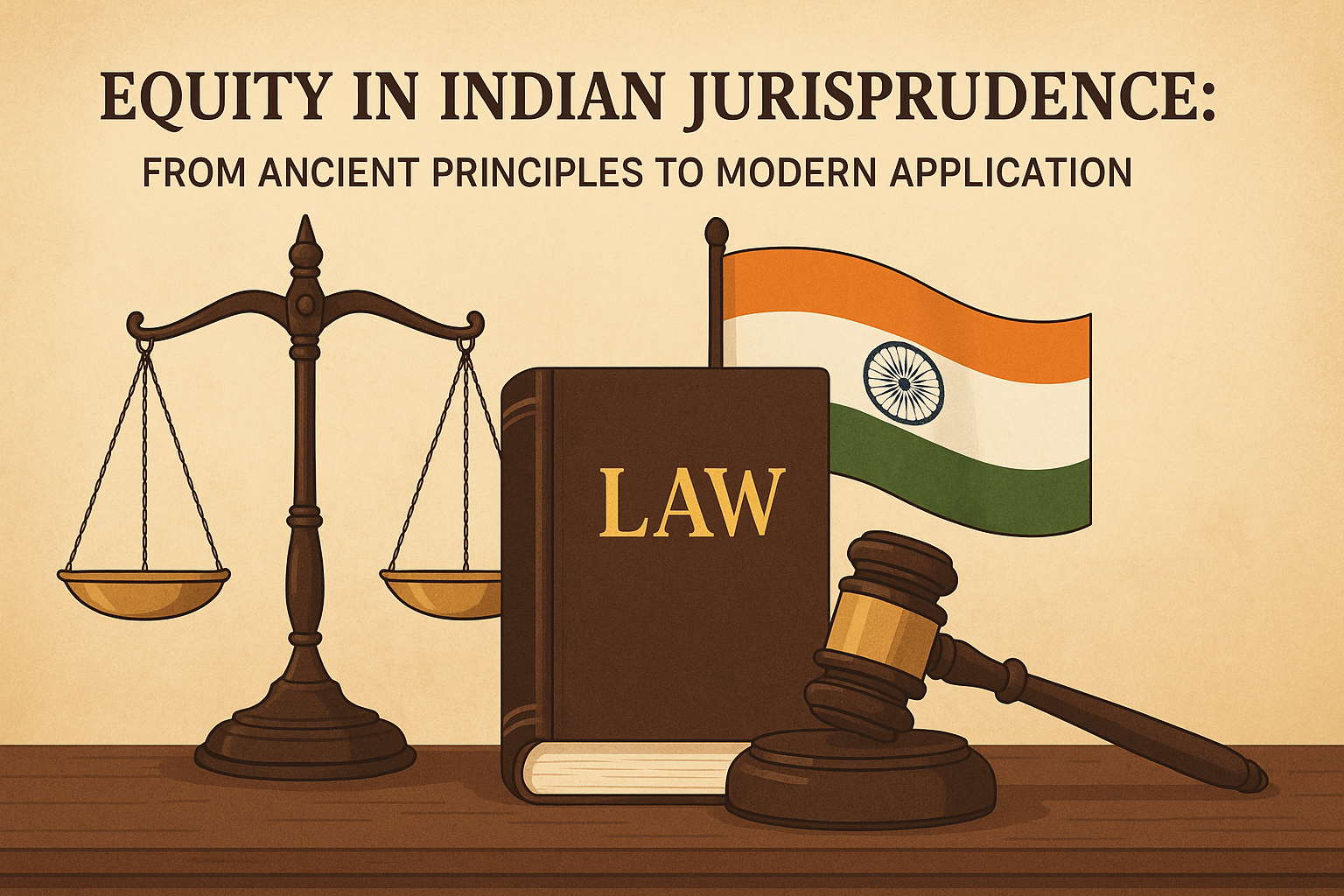


JURISPRUDENCE | July 11, 2025
EQUITY IN INDIAN JURISPRUDENCE: FROM ANCIENT PRINCIPLES TO MODERN APPLICATION
This Article is written by Shrutika Bsc.LL.B. (Hons.) at National Forensic Sciences University
Equity isn’t just a rigid or dogmatic idea; it’s a living principle that evolves with changing interpretations and historical context. This legal research takes a closer look at the roots of equity, its essential role in fostering justice, and how it plays out in contemporary Indian law. It also examines important legal maxims that steer equitable principles, showcasing how equity helps fill the gaps left by strict legal rules and promotes fairness when the law might not be enough.
INTRODUCTION
The word "equity" has its roots in the Latin term "aequitas," which translates to suitability, justice, moderation, and impartiality. For the ancient Greeks, the word "epieikeia" carried a deeper meaning related to social justice, aimed at enhancing the law. This concept, with its universal nature, highlighted a significant gap in fairness. Epieikeia embodies a unique perspective of a true judge and a fair-minded individual. The judge isn't just there to mechanically hand out penalties for offenses; instead, he must temper the strictness of the law with a sense of fairness. This means considering the specific circumstances and the social standing of the person seeking justice, allowing for a more compassionate approach that softens the harshness of the law.
Aristotle defined the rule of law as reason free from all passion, with its ultimate purpose being the attainment of eudaimonia (human flourishing). Yet, he also pointed out a significant flaw in the law's generality and championed the idea of epieikeia, which translates to equity. He defined equity as “rectification of law where it is defective because of its generality.” Aristotle believed that laws usually reflect the average case and the majority's opinion, often overlooking unique or exceptional situations. In these instances, judges might need to step beyond the strict wording of the law and take on a more legislative role themselves.
ORIGIN OF EQUITY
- Common System
Before the evolution of equity, common law was the prevalent law in England. Common law has evolved over the years through various court cases and was overseen by the King’s justices in three primary courts:
- The King’s Bench: This court took on both civil and criminal cases involving the Crown.
- The Court of Common Pleas: This court focused on civil disputes between individuals.
- The Court of Exchequer: This court was primarily concerned with issues related to royal revenue.
The system was quite strict, as anyone seeking legal remedy had to secure a writ from the King’s Chancellor, outlining a valid reason for their case. Without that necessary writ, no legal action could be initiated, which often made it difficult for people to access justice.
- Establishment of the Court of Chancery
By the thirteenth century, people started turning to the Chancellor—often called the "keeper of the King's conscience"—to find fairer solutions that went beyond the strict boundaries of common law. This push led to the establishment of the Court of Chancery, where decisions were rooted in fairness and reason, laying the groundwork for equity. The Lord Chancellors crafted principles that highlighted justice, introducing new rights and responsibilities that common law frequently missed.
At first, equity served as a complement to common law, addressing its shortcomings. However, as both systems progressed, tensions began to surface. This conflict reached a climax in the Earl of Oxford’s Case (1615), when King James I decided that equity would take precedence in case of a dispute.
- Judicature Act 1873-75
By the mid-nineteenth century, it became clear that the two legal systems could no longer function independently, and a review of the system was necessary. This change was brought about by the Judicature Act of 1873-75. This important legislation merged the two systems into a single court hierarchy, laying the groundwork for the modern divisions we see in today’s High Court. Instead of abolishing equity, the Acts actually reinforced its significance for the future. Now, a litigant could initiate their case in one court that would apply both common law and equity rules, with the Judicature Acts ensuring that, in the event of a conflict, equity would take precedence.
PRINCIPLES OF EQUITY
- Equity Will Not Suffer a Wrong to be Without a Remedy:
- Meaning: Where there is a right, there is a remedy. This idea is expressed in the Latin maxim ubijus ibi remedium. It means that no wrong should go unredressed if it is capable of being remedied by courts. This maxim indicates the width of the scope and the basis on which the structure of equity rests.
- Equity Follows the Law:
- Meaning: The maxim reflects the discipline that the Chancery Courts maintained while delivering justice based on conscience. Equity wasn't meant to undermine the common law; rather, it aimed to enhance and complete it.
- Application in India: In Appa Narsappa Magdum (D) Thr. Lrs vs. Akubai Ganapati Nimbalkar and Ors. The appeal was rejected by the Supreme Court of India, contending that “When provision of law is clear then no relief granted on basis of equity.”
- He Who Seeks Equity Must Do Equity:
- Meaning: This maxim signifies that a person seeking an equitable remedy must act fairly and ethically. The individual must not only demand justice but must also demonstrate fairness in their own conduct.
- Delay Defeats Equities:
- Meaning: When an individual has delayed seeking a remedy for a wrong, and has, over a significant period, appeared largely indifferent to the issue, the court is likely to refuse that remedy.
- Equality Is Equity:
- Meaning: Equity operates on the principle that individuals with similar rights and claims should be treated equally. In cases of joint ownership or conflicting claims, courts divide the rights or interests fairly.
- Application in India: The maxim has been recognized in India under various enactments – Contract Act, Section 42, illustrates tenancy in common as regards devolution of liabilities, Section 43 illustrates that one of a number of joint promisors who has performed the promise is entitled to compel the other promisors to contribute equally with him.
- Equity Acts in Personam:
- Meaning: While common law often focuses on remedies related to property, equity is more about holding individuals accountable. This means that courts can issue orders like injunctions and specific performance, compelling people to either take action or avoid certain behaviours.
APPLICATION OF EQUITY IN INDIAN LAW
In India, equity isn't laid out as a standalone legal system; instead, it's woven into the fabric of the law through principles and precedents that courts apply. These equitable principles are found in various statutes and legal frameworks, stepping in to provide remedies when a strict interpretation of the law might lead to unfair outcomes. Some key pieces of legislation that incorporate equity include:
- The Indian Contract Act, 1872:
Equity is essential in contract law, particularly through remedies like specific performance, injunctions, and rectification. These remedies come into play when one party has been treated unfairly or when enforcing a contractual obligation is crucial for achieving fairness.
- Sections 64 and 65 embody the equitable maxim: “He who seeks equity must do equity.”
- The Specific Relief Act, 1877:
This Act provides a comprehensive framework for equitable remedies. Key sections include:
- Sections 12–20: Specific performance—outlining when contracts can or cannot be enforced.
- Sections 21–30: Addressing contracts that aren’t specifically enforceable.
- Sections 31–34: Covering the rectification of instruments.
- Sections 35–38: Discussing the rescission of contracts.
- Sections 39–41: Focusing on the cancellation of instruments.
- Sections 42–43: Dealing with declaratory decrees and their implications.
- Section 44: Outlining the appointment of a receiver.
- Sections 52–57: Providing for preventive relief, such as injunctions.
- The Indian Trusts Act, 1882:
This Act lays out the responsibilities of trustees, making it clear that they must always act in the best interests of the beneficiaries. Equity demands that trustees handle trust property with care, loyalty, and good faith—these are the core principles that guide their obligations.
- Intellectual Property Law:
Equity is crucial in the realm of IP law, especially when it comes to issuing injunctions to stop trademark or copyright violations. These equitable remedies are designed to ensure that those who infringe don’t gain unfair advantages, while also safeguarding the rights of the rightful owners.
- The Transfer of Property Act, 1882:
This Act encompasses several important equitable doctrines, including:
- Section 35: The Doctrine of Election.
- Section 43: Feeding the Grant by Estoppel.
- Sections 48–51: Priorities and Rights Based on Equitable Principles.
- Section 53: Fraudulent Transfers.
- Section 53A: The Doctrine of Part Performance (adapted from English equity).
- The Indian Succession Act, 1925:
- Sections 180–190 of this Act apply the Doctrine of Election in the realm of wills, another principle taken from equity to help settle conflicting inheritance claims.
CONCLUSION
The evolution of equity, which began in sixteenth-century England as a way to counter the strictness of common law, has significantly shaped the Indian legal system. While equity has become a key component of legislation in England, in India, it still operates through a mix of statutory laws and judicial interpretation. The Indian legal framework, grounded in principles of justice, fairness, and conscience, actively promotes equitable principles through various laws and court decisions. Equity is crucial in filling the gaps left by rigid legal rules, ensuring that justice is not just achieved but also perceived as being achieved. By providing adaptable remedies and focusing on concepts like good faith, fiduciary duty, and fairness, equity reinforces the moral underpinnings of Indian law and remains essential in the quest for true justice.
REFERENCES
- Camelia IGN?TESCU, Equity- the Essential Value of Law, 4 Postmodern Openings J. 25-33, (2013).https://www.researchgate.net/publication/286528633_Equity-_the_Essential_Value_of_Law
- Dr Rajesh Kumar, EQUITY PRINCIPLES UNDER INDIAN LEGAL SYSTEM AND IT’S RELEVANCE IN CONTEMPORARY ERA: A CRITICAL STUDY, VOL. 7 IJNRD, (2022). https://www.ijnrd.org/papers/IJNRD2211267.pdf
- Steve Sheppard, EQUITY AND THE LAW, Encyclopedia of Life Support Systems (EOLSS), https://www.eolss.net/Sample-Chapters/C04/E6-31-03-02.pdf.
- Appa Narsappa Magdum (D) Thr. Lrs vs. Akubai Ganapati Nimbalkar and Ors. (04.05.1999 - SC): MANU/SC/0375/1999.
- THE INDIAN CONTRACT ACT, 1872. https://www.indiacode.nic.in/bitstream/123456789/2187/2/A187209.pdf
- The Specific Relief Act, 1877. https://www.advocatekhoj.com/library/lawreports/specificreliefact/index.php?Title=Specific%20Relief%20Act,%201877
- THE TRANSFER OF PROPERTY ACT, 1882. https://www.indiacode.nic.in/bitstream/123456789/2338/1/A1882-04.pdf
- THE INDIAN SUCCESSION ACT, 1925. https://www.indiacode.nic.in/bitstream/123456789/2385/1/a1925-39.pdf



Comments (0)